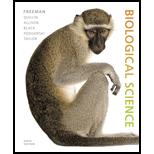
Introduction:
The spiracles are the valve-like structures present in the exoskeleton of insects, which can be opened or closed as per the requirement.
Answer to Problem 1TYK
Correct answer:
The spiracles close off the tracheae to minimize the water loss in the insects.
Explanation of Solution
Explanation/Justification for the correct answer:
Option (d) is given that the function of the spiracles in the insects is to close the tracheae to regulate the loss of water from the body. Insects have adopted a different type of respiratory system called the tracheal system. The insects have tracheae (air-filled tubes) located within their bodies. These tubes are connected to the external environment through spiracles. The air moves into the spiracles from the environment. The air then moves inside the insect’s body through the tracheae. The closing of spiracles is controlled by the CNS (central nervous system) as well as the
Explanation for incorrect answers:
Option (a) is given that the spiracles dilate and constrict during flight or other types of movement, functioning as a breathing mechanism in the insects. The spiracles do not dilate and constrict during flight or other movements of the insect only. They dilate and constrict even when the insect relaxes. So, it is a wrong answer.
Option (b) is given that the spiracles open into the body cavity, allowing direct contact between hemolymph and tissues in the insects. The spiracles do not open into the body cavity. These are the openings present on the outer surface. So, it is a wrong answer.
Option (c) is given that in the insects, the spiracles are thin and highly branched, offering a large surface area for the exchange of gases. In the insects, the trachea is highly branched structure and not the spiracles, which provide a large surface area for gas exchange. So, it is a wrong answer.
Hence, options (a), (b), and (c) are incorrect.
Thus, the closing of the spiracles closes the tracheae and it minimizes the water loss from the insect’s body.
Want to see more full solutions like this?
Chapter 42 Solutions
Biological Science (6th Edition)
- What is behavioral adaptarrow_forward22. Which of the following mutant proteins is expected to have a dominant negative effect when over- expressed in normal cells? a. mutant PI3-kinase that lacks the SH2 domain but retains the kinase function b. mutant Grb2 protein that cannot bind to RTK c. mutant RTK that lacks the extracellular domain d. mutant PDK that has the PH domain but lost the kinase function e. all of the abovearrow_forwardWhat is the label ?arrow_forward
- Can you described the image? Can you explain the question as well their answer and how to get to an answer to an problem like this?arrow_forwardglg 112 mid unit assignment Identifying melting processesarrow_forwardGive only the mode of inheritance consistent with all three pedigrees and only two reasons that support this, nothing more, (it shouldn't take too long)arrow_forward
- Oarrow_forwardDescribe the principle of homeostasis.arrow_forwardExplain how the hormones of the glands listed below travel around the body to target organs and tissues : Pituitary gland Hypothalamus Thyroid Parathyroid Adrenal Pineal Pancreas(islets of langerhans) Gonads (testes and ovaries) Placentaarrow_forward

 Biology: The Dynamic Science (MindTap Course List)BiologyISBN:9781305389892Author:Peter J. Russell, Paul E. Hertz, Beverly McMillanPublisher:Cengage Learning
Biology: The Dynamic Science (MindTap Course List)BiologyISBN:9781305389892Author:Peter J. Russell, Paul E. Hertz, Beverly McMillanPublisher:Cengage Learning





